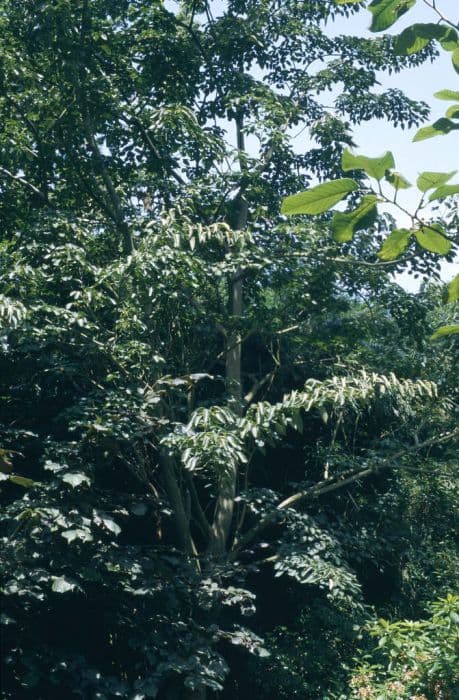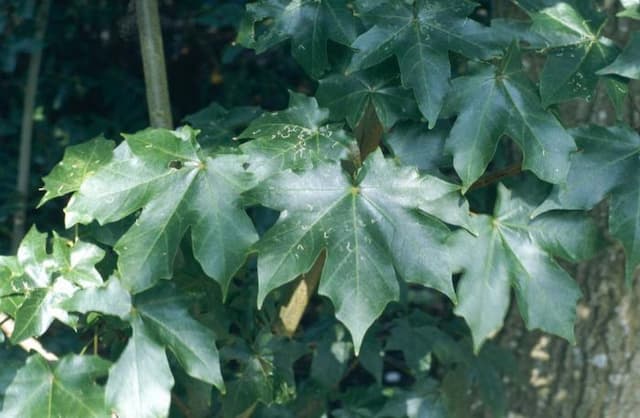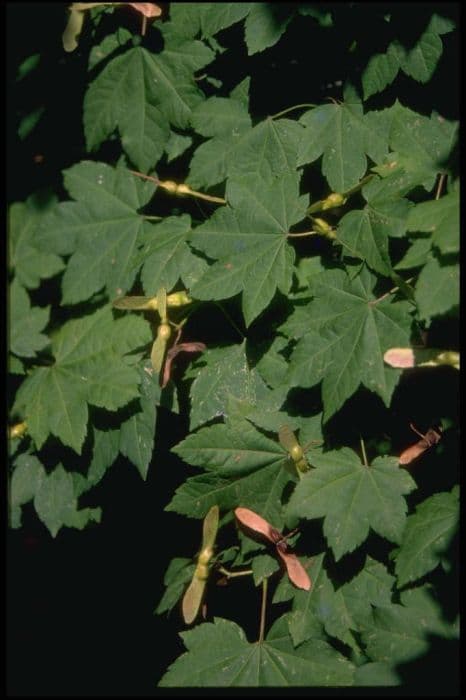Japanese Maple Acer palmatum 'Bi Ho' (P)

ABOUT
Japanese maple 'Bi Ho' is an ornamental plant known for its distinctive seasonal color changes and architectural structure. It features a captivating display of leaves that change throughout the year. In spring, the foliage emerges in a vivid chartreuse hue, providing a bright burst of color that can enliven any garden space. As the seasons progress, these leaves transition into a deeper green, maintaining their lush and vibrant appearance well into the warmer months. What truly sets the 'Bi Ho' apart are its unique winter characteristics. During this season, the stems of the plant take center stage. They exhibit an alluring golden-yellow color, offering a stark and beautiful contrast against the often gray and somber winter landscape. This striking feature provides year-round interest, ensuring that the plant remains a focal point in the garden even when it has shed its leaves. The arrangement of the leaves is equally noteworthy, being palmate with multiple lobes, reminiscent of the outspread fingers of a hand. Each leaf is finely serrated along the edges, which adds a delicate texture and intricate look to the overall form of the plant. The Japanese maple 'Bi Ho' also possesses a graceful growth habit. Its branches spread outward in an elegant fashion, creating a layered and somewhat cascading appearance. This growth pattern contributes to the plant's natural charm and its ability to serve as a stunning stand-alone specimen or as a complementary element within a diverse planting scheme. In summary, the Japanese maple 'Bi Ho' captivates with its vibrant spring leaves, green summer foliage, and radiant golden stems in winter, paired with a delicately lobed leaf structure and an elegant branch silhouette. It's a plant that provides visual appeal throughout the year without reference to its size.
About this plant
 Names
NamesFamily
Sapindaceae
Synonyms
Japanese Maple, Smooth Japanese Maple
Common names
Acer palmatum 'Bi-ho'
 Toxicity
ToxicityTo humans
The Japanese maple is not known to be toxic to humans. Therefore, ingestion of its parts is not typically associated with poisoning or harmful symptoms in people.
To pets
The Japanese maple is generally considered to be non-toxic to pets as well. There should be no symptoms of poisoning or severe consequences in pets as a result of ingesting any part of this plant. However, it is always prudent to prevent pets from consuming plants as individual animals might react differently, and ingestion of non-food items can sometimes cause gastrointestinal upset or blockages.
 Characteristics
CharacteristicsLife cycle
Perennials
Foliage type
Deciduous
Color of leaves
Varies
Height
6-8 feet (1.8-2.4 meters)
Spread
4-6 feet (1.2-1.8 meters)
Plant type
Tree
Hardiness zones
5-8
Native area
Japan
Benefits
 General Benefits
General Benefits- Aesthetic Appeal: The Acer palmatum 'Bi Ho', commonly known as Japanese Maple 'Bi Ho', adds visual interest to landscapes with its unique yellow to chartreuse winter bark and attractive green summer foliage.
- Seasonal Color: This variety provides year-round interest with foliage that changes color throughout the seasons, displaying hues of green, gold, and sometimes crimson.
- Shade Provision: Its canopy creates a cool, shaded area beneath, which can be beneficial for understory plants and as a comfortable retreat on sunny days.
- Wildlife Habitat: The Japanese Maple 'Bi Ho' can serve as a habitat and food source for various species of birds and insects, contributing to biodiversity.
- Compact Size: With a moderate growth rate and relatively small mature size, it fits well into smaller gardens or as a feature in larger landscapes without overwhelming the space.
- Erosion Control: This deciduous tree's root system helps stabilize the soil, mitigating erosion on slopes or in areas susceptible to soil loss.
- Cultural Significance: Japanese Maples, including 'Bi Ho', have cultural importance in Japanese gardening and are often used in traditional garden designs, symbolizing peace and serenity.
- Privacy Screen: When planted in groups, these trees can form loose barriers or screens that add privacy to gardens and outdoor spaces.
 Medical Properties
Medical PropertiesThis plant is not used for medical purposes.
 Air-purifying Qualities
Air-purifying QualitiesThis plant is not specifically known for air purifying qualities.
 Other Uses
Other Uses- The Japanese Maple 'Bi Ho' can be utilized in bonsai cultivation due to its small leaves, interesting branch structure, and vibrant seasonal colors.
- Its wood, being relatively hard and having a fine grain, is occasionally used in woodworking for making small objects or inlays that require detail and precision.
- In photography and painting, the Japanese Maple 'Bi Ho' often serves as a subject for artists because of its striking aesthetics and seasonal color changes.
- This variety, with its unique colored bark, can be used in winter gardens to provide color contrast against snow or evergreens.
- The bark of the Japanese Maple 'Bi Ho' can be used for creating natural dyes, offering subtle colors for fabrics or art projects.
- Leaves from the Japanese Maple 'Bi Ho' can be pressed and preserved in books, used for crafts, or even as educational materials in botany classes.
- The seeds of the Japanese Maple 'Bi Ho' can be collected and used as part of a seed exchange program, helping to spread biodiversity and appreciation for unique plant varieties.
- Being a relatively small tree, the Japanese Maple 'Bi Ho' is ideal for urban and small-space gardening where larger trees cannot be accommodated.
- With its dense foliage, Japanese Maple 'Bi Ho' can be used in gardens to create a natural privacy screen or to cast a soft, filtered shade.
- Creative landscape designers might incorporate the fallen leaves of the Japanese Maple 'Bi Ho' into their compositions, using them to add color and texture to the garden floor.
Interesting Facts
 Feng Shui
Feng ShuiThe Japanese Maple is known for its graceful beauty and vibrant foliage, which can bring a sense of calm and serenity into a garden or home. In Feng Shui, placing a Japanese Maple in the East for family harmony or Southeast for wealth attraction is believed to enhance these areas due to its wood element. Its red leaves can also add the fire element, promoting positive energy flow.
 Zodiac Sign Compitability
Zodiac Sign CompitabilityThe Japanese Maple is not used in astrology practice.
 Plant Symbolism
Plant Symbolism- Beauty: The striking appearance of the Japanese maple, with its delicate leaves and varying colors, commonly symbolizes beauty in the plant world.
- Peace: The serene growth habit and calming presence of the Japanese maple can evoke a sense of peace and tranquility.
- Balancing Contrast: With its leaves that change color with the seasons, the Japanese maple is often seen as a symbol of the balance between contrasting forces, reflecting the transient nature of life.
- Endurance and Strength: Despite its delicate appearance, the Japanese maple is quite resilient, and it can represent the ability to endure and remain strong through adversity.
- Elegance: The graceful form of the Japanese maple and its refined structure symbolize elegance and sophistication.
 Water
WaterFor the Japanese Maple 'Bi Ho', water should be applied deeply and thoroughly, rather than frequently with small amounts to encourage deep root growth. It typically requires watering once a week, but this can vary depending on the weather and soil conditions. During the hot summer months, you might need to water twice a week, while in cooler weather, less frequent watering is necessary. Aim for about 1.5 to 2 gallons of water per watering session for an established tree, ensuring the soil is moist but not waterlogged. During the winter, watering can be reduced as the plant's growth slows down.
 Light
LightJapanese Maples, including 'Bi Ho', thrive in a spot with partial shade, although they can tolerate morning sun. The ideal location will have protection from harsh afternoon sunlight, especially in hotter climates. Dappled sunlight underneath larger trees or on the north or east side of a building is perfect for this cultivar, as bright, indirect light encourages vibrant leaf color without the risk of leaf scorch.
 Temperature
TemperatureThe Japanese Maple 'Bi Ho' can endure temperatures as low as 20°F but prefers a temperate climate for optimal growth. Ideal growing temperatures range between 60°F and 75°F. While they can survive short heat waves, prolonged exposure to temperatures above 90°F can cause stress and leaf burn, so providing shade and mulch can help to regulate root temperatures in extreme heat.
 Pruning
PruningPruning the Japanese Maple 'Bi Ho' is mainly for aesthetic reasons and to maintain plant health by removing dead or crossing branches. The best time to prune is in late winter or early spring when the tree is dormant and before new growth starts. Pruning should be limited to once a year, and care should be taken to retain the tree's natural shape.
 Cleaning
CleaningAs needed
 Soil
SoilJapanese Maple 'Bi Ho' thrives in well-draining soil that is rich in organic matter. The best soil mix for this variety typically consists of one part peat, one part pine bark, and one part coarse sand or perlite. It prefers a slightly acidic to neutral pH, ideally between 5.5 and 7.0.
 Repotting
Repotting'Bi Ho' Japanese Maple should be repotted every two to three years to prevent root-binding and to refresh the soil. Younger trees may need repotting more frequently, while mature trees can be done less often.
 Humidity & Misting
Humidity & MistingJapanese Maple 'Bi Ho' prefers moderate humidity levels but is adaptable to different atmospheric conditions as long as it is not in a constantly dry environment.
 Suitable locations
Suitable locationsIndoor
Place 'Bi Ho' Japanese Maple in bright, indirect light indoors.
Outdoor
Plant 'Bi Ho' Maple in partial shade, sheltered from strong winds.
Hardiness zone
5-8 USDA
 Life cycle
Life cycleThe Japanese Maple 'Bi-Ho' begins its life as a seed, which germinates in a warm, moist environment, typically in spring. The seedling emerges, establishing roots and a shoot that will develop into its distinctive multi-branched form. As it enters the juvenile phase, the young maple experiences rapid growth and begins to exhibit its characteristic palmate leaves, which change color with seasons. During the maturity stage, the Japanese Maple 'Bi-Ho' reaches its full size, displaying vibrant yellow or chartreuse bark in winter and colorful foliage in autumn. The tree enters a period of reproductive maturity, producing small, attractive red or purple flowers followed by samaras, or winged seeds, that disperse to start a new generation. With proper care, the Japanese Maple 'Bi-Ho' can live for several decades, eventually reaching a senescence phase where growth slows before the tree dies.
 Propogation
PropogationPropogation time
Late winter
The Japanese Maple 'Bi Ho' is most effectively propagated by softwood cuttings or grafting. Softwood cuttings are typically taken in late spring or early summer when new growth is still flexible and not fully matured. To propagate by softwood cuttings, select a healthy branch and cut a 4 to 6-inch (10 to 15 centimeters) section with several leaves. Dip the cut end into rooting hormone to encourage root development and place it in a well-draining soil mixture. Keep the soil consistently moist and maintain high humidity around the cutting by using a plastic cover or a propagation dome. Roots typically develop in a few weeks, after which the young plant can be gradually acclimatized to less humid conditions before planting out. This method preserves the exact characteristics of the 'Bi Ho' cultivar, allowing gardeners to propagate true-to-type specimens.





![Freeman maple [Autumn Blaze]](/_next/image?url=https%3A%2F%2Fplants-admin.emdemapps.com%2Fimages%2Fplants%2F%2Fimages%2F604b575b84d87.png&w=640&q=75)



